
CHAPTER 1
1.1. Given the vectors M=−10ax+4ay−8azand N=8ax+7ay−2az, find:
a) a unit vector in the direction of −M+2N.
−M+2N=10ax−4ay+8az+16ax+14ay−4az= (26,10,4)
Thus
a=(26,10,4)
|(26,10,4)|=(0.92,0.36,0.14)
b) the magnitude of 5ax+N−3M:
(5,0,0)+(8,7,−2) −(−30,12,−24) = (43,−5,22), and |(43,−5,22)|=48.6.
c) |M||2N|(M+N):
|(−10,4,−8)||(16,14,−4)|(−2,11,−10) = (13.4)(21.6)(−2,11,−10)
=(−580.5,3193,−2902)
1.2. The three vertices of a triangle are located at A(−1,2,5), B(−4,−2,−3), and C(1,3,−2).
a) Find the length of the perimeter of the triangle: Begin with AB =(−3,−4,−8), BC =(5,5,1),
and CA =(−2,−1,7). Then the perimeter will be ℓ=|AB|+|BC|+|CA|=√9+16+64+
√25+25+1+√4+1+49=23.9.
b) Find a unit vector that is directed from the midpoint of the side AB to the midpoint of side
BC: The vector from the origin to the midpoint of AB is MAB =1
2(A+B)=1
2(−5ax+2az).
The vector from the origin to the midpoint of BC is MBC =1
2(B+C)=1
2(−3ax+ay−5az).
The vector from midpoint to midpoint is now MAB −MBC =1
2(−2ax−ay+7az). The unit
vector is therefore
aMM =MAB −MBC
|MAB −MBC|=(−2ax−ay+7az)
7.35 =−0.27ax−0.14ay+0.95az
where factors of 1/2have cancelled.
c) Show that this unit vector multiplied by a scalar is equal to the vector from Ato Cand that the
unit vector is therefore parallel to AC. First we find AC =2ax+ay−7az, which we recognize
as −7.35 aMM. The vectors are thus parallel (but oppositely-directed).
1.3. The vector from the origin to the point Ais given as (6,−2,−4), and the unit vector directed from
the origin toward point Bis (2,−2,1)/3. If points Aand Bare ten units apart, find the coordinates
of point B.
With A=(6,−2,−4) and B=1
3B(2,−2,1), we use the fact that |B−A|= 10, or
|(6 −2
3B)ax−(2 −2
3B)ay−(4 + 1
3B)az|=10
Expanding, obtain
36 −8B+4
9B2+4−8
3B+4
9B2+16+8
3B+1
9B2= 100
or B2−8B−44=0. ThusB=8±√64−176
2=11.75 (taking positive option) and so
B=2
3(11.75)ax−2
3(11.75)ay+1
3(11.75)az=7.83ax−7.83ay+3.92az
1

1.4. A circle, centered at the origin with a radius of 2 units, lies in the xy plane. Determine the unit
vector in rectangular components that lies in the xy plane, is tangent to the circle at (√3,1,0), and
is in the general direction of increasing values of y:
A unit vector tangent to this circle in the general increasing ydirection is t=aφ. Its xand y
components are tx=aφ·ax=−sin φ, and ty=aφ·ay= cos φ.Atthe point (√3,1), φ=30
◦,
and so t=−sin 30◦ax+ cos 30◦ay=0.5(−ax+√3ay).
1.5. Avector field is specified as G=24xyax+ 12(x2+2)ay+18z2az. Given two points, P(1,2,−1)
and Q(−2,1,3), find:
a) Gat P:G(1,2,−1) = (48,36,18)
b) a unit vector in the direction of Gat Q:G(−2,1,3)=(−48,72,162), so
aG=(−48,72,162)
|(−48,72,162)|=(−0.26,0.39,0.88)
c) a unit vector directed from Qtoward P:
aQP =P−Q
|P−Q|=(3,−1,4)
√26 =(0.59,0.20,−0.78)
d) the equation of the surface on which |G|= 60: We write 60 = |(24xy, 12(x2+2),18z2)|,or
10 = |(4xy, 2x2+4,3z2)|,sothe equation is
100 = 16x2y2+4x4+16x2+16+9z4
1.6. If ais a unit vector in a given direction, Bis a scalar constant, and r=xax+yay+zaz, describe
the surface r·a=B. What is the relation between the the unit vector aand the scalar Bto this
surface? (HINT: Consider first a simple example with a=axand B=1,and then consider any a
and B.):
We could consider a general unit vector, a=A1ax+A2ay+A3az, where A2
1+A2
2+A2
3=1.
Then r·a=A1x+A2y+A3z=f(x, y, z)=B. This is the equation of a planar surface, where
f=B. The relation of ato the surface becomes clear in the special case in which a=ax.We
obtain r·a=f(x)=x=B, where it is evident that ais a unit normal vector to the surface
(as a look ahead (Chapter 4), note that taking the gradient of fgives a).
1.7. Given the vector field E=4zy2cos 2xax+2zy sin 2xay+y2sin 2xazfor the region |x|,|y|, and |z|
less than 2, find:
a) the surfaces on which Ey=0. With Ey=2zy sin 2x=0,the surfaces are 1) the plane z=0
,
with |x|<2, |y|<2; 2) the plane y=0
, with |x|<2, |z|<2; 3) the plane x=0, with |y|<2,
|z|<2; 4) the plane x=π/2, with |y|<2, |z|<2.
b) the region in which Ey=Ez: This occurs when 2zy sin 2x=y2sin 2x,oronthe plane 2z=y,
with |x|<2, |y|<2, |z|<1.
c) the region in which E=0:Wewould have Ex=Ey=Ez=0,orzy2cos 2x=zy sin 2x=
y2sin 2x=0. This condition is met on the plane y=0
, with |x|<2, |z|<2.
2

1.8. Demonstrate the ambiguity that results when the cross product is used to find the angle between
two vectors by finding the angle between A=3ax−2ay+4azand B=2ax+ay−2az.Does this
ambiguity exist when the dot product is used?
We use the relation A×B=|A||B|sin θn. With the given vectors we find
A×B=14ay+7az=7
√52ay+az
√5
±n
=√9+4+16
√4+1+4sinθn
where nis identified as shown; we see that ncan be positive or negative, as sin θcan be
positive or negative. This apparent sign ambiguity is not the real problem, however, as we
really want the magnitude of the angle anyway. Choosing the positive sign, we are left with
sin θ=7
√5/(√29√9)=0.969. Two values of θ(75.7◦and 104.3◦) satisfy this equation, and
hence the real ambiguity.
In using the dot product, we find A·B=6−2−8=−4=|A||B|cos θ=3
√29 cos θ,or
cos θ=−4/(3√29) = −0.248 ⇒θ=−75.7◦. Again, the minus sign is not important, as we
care only about the angle magnitude. The main point is that only one θvalue results when
using the dot product, so no ambiguity.
1.9. A field is given as
G=25
(x2+y2)(xax+yay)
Find:
a) a unit vector in the direction of Gat P(3,4,−2): Have Gp=25/(9 +16)×(3,4,0) = 3ax+4ay,
and |Gp|=5. ThusaG=(0.6,0.8,0).
b) the angle between Gand axat P: The angle is found through aG·ax= cos θ.Socos θ=
(0.6,0.8,0) ·(1,0,0)=0.6. Thus θ=53
◦.
c) the value of the following double integral on the plane y=7:
4
02
0
G·aydzdx
4
02
0
25
x2+y2(xax+yay)·aydzdx =4
02
0
25
x2+49×7dzdx =4
0
350
x2+49dx
= 350 ×1
7tan−14
7−0=26
1.10. By expressing diagonals as vectors and using the definition of the dot product, find the smaller angle
between any two diagonals of a cube, where each diagonal connects diametrically opposite corners,
and passes through the center of the cube:
Assuming a side length, b,two diagonal vectors would be A=b(ax+ay+az) and B=
b(ax−ay+az). Now use A·B=|A||B|cos θ,orb2(1 −1+1)=(
√3b)(√3b) cos θ⇒cos θ=
1/3⇒θ=70.53◦. This result (in magnitude) is the same for any two diagonal vectors.
3

1.11. Given the points M(0.1,−0.2,−0.1), N(−0.2,0.1,0.3), and P(0.4,0,0.1), find:
a) the vector RMN:RMN =(−0.2,0.1,0.3) −(0.1,−0.2,−0.1) = (−0.3,0.3,0.4).
b) the dot product RMN ·RMP :RMP =(0.4,0,0.1) −(0.1,−0.2,−0.1)=(0.3,0.2,0.2). RMN ·
RMP =(−0.3,0.3,0.4) ·(0.3,0.2,0.2) = −0.09 + 0.06 + 0.08=0.05.
c) the scalar projection of RMN on RMP:
RMN ·aRMP =(−0.3,0.3,0.4) ·(0.3,0.2,0.2)
√0.09+0.04+0.04 =0.05
√0.17 =0.12
d) the angle between RMN and RMP:
θM= cos−1RMN ·RMP
|RMN||RMP |= cos−10.05
√0.34√0.17=78
◦
1.12. Show that the vector fields A=ρcos φaρ+ρsin φaφ+ρazand B=ρcos φaρ+ρsin φaφ−ρaz
are everywhere perpendicular to each other:
We find A·B=ρ2(sin2φ+ cos2φ)−ρ2=0=|A||B|cos θ. Therefore cos θ=0orθ=90
◦.
1.13. a) Find the vector component of F= (10,−6,5) that is parallel to G=(0.1,0.2,0.3):
F||G=F·G
|G|2G=(10,−6,5) ·(0.1,0.2,0.3)
0.01+0.04+0.09 (0.1,0.2,0.3) = (0.93,1.86,2.79)
b) Find the vector component of Fthat is perpendicular to G:
FpG =F−F||G= (10,−6,5) −(0.93,1.86,2.79)=(9.07,−7.86,2.21)
c) Find the vector component of Gthat is perpendicular to F:
GpF =G−G||F=G−G·F
|F|2F=(0.1,0.2,0.3) −1.3
100 + 36+25(10,−6,5) = (0.02,0.25,0.26)
1.14. Show that the vector fields A=ar(sin 2θ)/r2+2aθ(sin θ)/r2and B=rcos θar+raθare everywhere
parallel to each other:
Using the definition of the cross product, we find
A×B=sin 2θ
r−2 sin θcos θ
raφ=0=|A||B|sin θn
Identify n=aφ, and so sin θ=0,and therefore θ=0(they’re parallel).
4

1.15. Three vectors extending from the origin are given as r1=(7,3,−2), r2=(−2,7,−3), and r3=
(0,2,3). Find:
a) a unit vector perpendicular to both r1and r2:
ap12 =r1×r2
|r1×r2|=(5,25,55)
60.6=(0.08,0.41,0.91)
b) a unit vector perpendicular to the vectors r1−r2and r2−r3:r1−r2=(9,−4,1) and r2−r3=
(−2,5,−6). So r1−r2×r2−r3= (19,52,32). Then
ap=(19,52,32)
|(19,52,32)|=(19,52,32)
63.95 =(0.30,0.81,0.50)
c) the area of the triangle defined by r1and r2:
Area = 1
2|r1×r2|=30.3
d) the area of the triangle defined by the heads of r1,r2, and r3:
Area = 1
2|(r2−r1)×(r2−r3)|=1
2|(−9,4,−1) ×(−2,5,−6)|=32.0
1.16. The vector field E=(B/ρ)aρ, where Bis a constant, is to be translated such that it originates at
the line, x=2,y=0.Write the translated form of Ein rectangular components:
First, transform the given field to rectangular components:
Ex=B
ρaρ·ax=B
x2+y2cos φ=B
x2+y2
x
x2+y2=Bx
x2+y2
Using similar reasoning:
Ey=B
ρaρ·ay=B
x2+y2sin φ=By
x2+y2
We then translate the two components to x=2,y =0,toobtain the final result:
E(x, y)=B[(x−2) ax+yay]
(x−2)2+y2
1.17. Point A(−4,2,5) and the two vectors, RAM = (20,18,−10) and RAN =(−10,8,15), define a
triangle.
a) Find a unit vector perpendicular to the triangle: Use
ap=RAM ×RAN
|RAM ×RAN |=(350,−200,340)
527.35 =(0.664,−0.379,0.645)
The vector in the opposite direction to this one is also a valid answer.
5


![Tài liệu ôn tập Điện trường [chuẩn nhất]](https://cdn.tailieu.vn/images/document/thumbnail/2025/20250709/linhnhil/135x160/31651752026408.jpg)
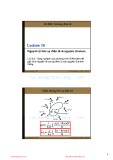

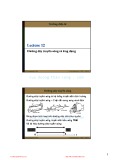

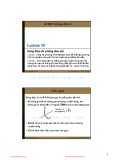
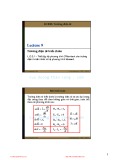
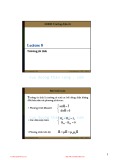
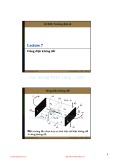








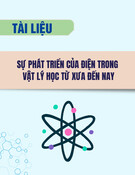
![Bộ câu hỏi lý thuyết Vật lý đại cương 2 [chuẩn nhất/mới nhất]](https://cdn.tailieu.vn/images/document/thumbnail/2025/20251003/kimphuong1001/135x160/74511759476041.jpg)
![Bài giảng Vật lý đại cương Chương 4 Học viện Kỹ thuật mật mã [Chuẩn SEO]](https://cdn.tailieu.vn/images/document/thumbnail/2025/20250925/kimphuong1001/135x160/46461758790667.jpg)




